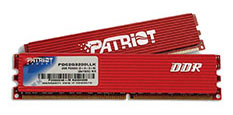Pre-AM2 Mid-Range Buyers' Guide, May 2006
by Jarred Walton on May 9, 2006 6:30 AM EST- Posted in
- Guides
Memory Recommendations
While we wait for AMD socket AM2 to launch, we still need to have separate memory recommendations for AMD and Intel systems. Just as I'm done recommending single core processors for midrange computers, I'm upgrading both systems to 2GB of RAM. If you're running a dual core processor and doing a lot of multitasking, the extra memory will definitely come in handy. Prices have also dropped to the point where even good quality 2GB kits don't cost that much. It was about 18 months ago that we stopped recommending 512MB configurations for midrange computers, which means it's about the right time to bump up to the next level of memory. Hopefully, in another 18 months we will be able to recommend 4GB of RAM for less than $200. |
| Click to enlarge |
DDR Memory: Patriot PC-3200 2x1024MB EPLL (2-3-2-5-1T)
Price: $190 shipped (Retail) - $55 Mail-In Rebate until 5/15/2006
Choosing a 2GB kit of DDR memory was actually relatively easy. There are kits out there that will overclock higher (without using lower memory ratios), but the majority of them cost quite a bit more. There are also a lot of mail-in rebates currently available for DDR memory, most likely due to the pending launch of AM2. This Patriot memory comes with the lowest timings you can find on any DDR 1GB DIMM, and it also happens to be one of the cheapest 1GB DIMMs available. My experience is that you can push the memory up to around DDR-450 with relaxed timings, so combined with the memory ratios on AMD motherboards you can still achieve good overclocks. If you're willing to spend a bit more money, Corsair, OCZ, G.Skill, Kingston, and Crucial are all reasonable alternatives - and potentially cheaper, depending on whether or not you take advantage of the mail-in rebate.
 |
| Click to enlarge |
DDR2 Memory: G.Skill PC-5300 2x1024MB Extreme LA (4-4-4-12)
Price: $148 shipped (Retail)
Moving to the DDR2 recommendation, there are thankfully no mail-in rebates to worry about. Balancing maximum bandwidth against latency and price, DDR2-667 looks to be the sweet spot. The G.Skill memory offers reasonable timings of 4-4-4 at that setting, and the price is only about $15 more than DDR2-533. A quick glance at the DDR price shows that without mail-in rebates, DDR2 definitely has the advantage, and a higher potential bandwidth doesn't hurt either. If you're thinking about DDR2 memory for the new socket AM2 platform, you might want to upgrade to DDR2-800 memory. That will bump the price up to $220 or more, but for Intel platforms we don't feel it's truly necessary (except for the extreme performance people that are buying $1000 P4XE processors). Should you spend the extra money right now to upgrade to DDR2-800, so that you can take it over to your AM2 platform in the future? Personally, I would say no - you can just sell off your current system and buy new memory if you upgrade motherboards and processors in the future. Six months from now, there will almost certainly be better DDR2 memory available anyway.










56 Comments
View All Comments
Griswold - Tuesday, May 9, 2006 - link
Shouldnt always go for the bigger number at a similar price. There are more important numbers with PSUs than the absolute wattage.KorruptioN - Tuesday, May 9, 2006 - link
Even though it's only rated at 400W overall (yes, wattage is not the best indicator of overall output), it can do 30A on the +12V output alone (360W divided by 12V), which is a good amount for a non-SLI configuration. Even two 7600GTs wouldn't be enough to push this power supply past it's limits. I think it is a good all-around choice.JarredWalton - Tuesday, May 9, 2006 - link
I've got a system very similar to this, only with a 7800 GTX, an overclocked X2 3800+, and two 250GB hard drives... all running off a Thermaltake 410W PSU. Maximum power draw hits about 315W - and that's not even counting for PSU efficiency (i.e. that's measuring at the outlet).I mentioned several alternative PSUs that people can consider. Why do I like modular units? Sleeved cables, reduced cable clutter, and for an extra $15 I'm willing to go that route. Opinions vary, naturally - this guide is basically my opinion, after all.
IntelUser2000 - Tuesday, May 9, 2006 - link
Sure about that. Only 35%?? I think 35% will be the absolute minimum over Netburst in Netburst optimized apps.
peternelson - Tuesday, May 9, 2006 - link
Difficult to make comparisons of "same price" netburst cpu, because Intel roadmap will make FURTHER REDUCTIONS in price of 930,940,950 after Core Duo 2 launches through November.950 probably isn't going to compete with the new chips on total performance, but may not be that bad in bang for buck in comparison.
JarredWalton - Tuesday, May 9, 2006 - link
Rough estimate, and it could be more or less depending on benchmarks. Core Duo T2300 costs a bit more than Pentium D 930. Looking at *stock* performance, AutoGK encoding for example should be around 55 FPS for the 930, while the T2400 get 44 FPS. Even with a 25% boost in performance, the Core Duo 2 $210 CPU is probably going to about equal PD 930.The flipped side is that some benches (games especially) will be more than 35%. PD 920 at 2.8 GHz maxes out at 63 FPS in BF2, roughly. (Doesn't matter about resolution - 800x600 still gets ~63 FPS.) Gary got 83 FPS with T2400 at stock, and 112 at 2.8 GHz. If CD2 gives another 25%... we're looking at maybe 104 FPS for a 1.83 GHz Core Duo 2. Assuming such a chip costs $210, it's got a 65% performance advantage. :)
Anyway, I'll tweak the text slightly.